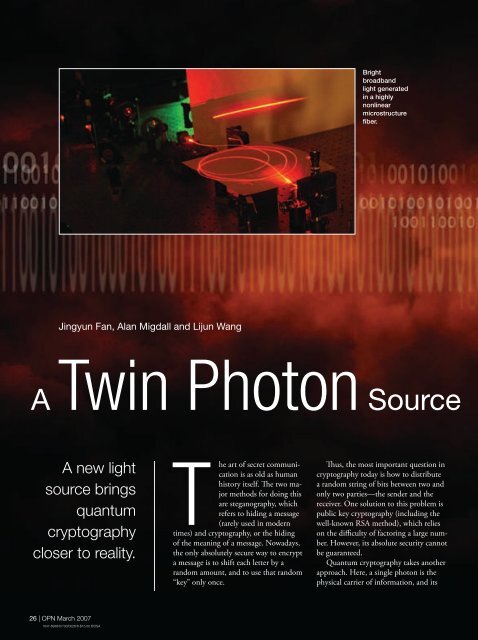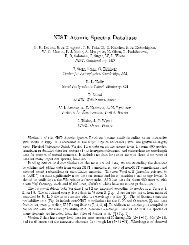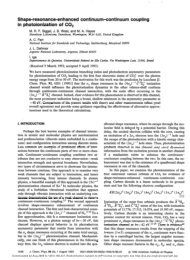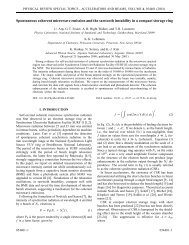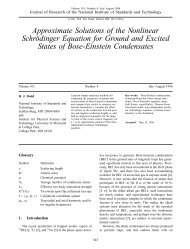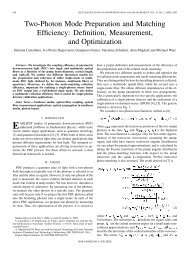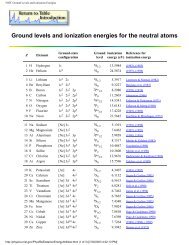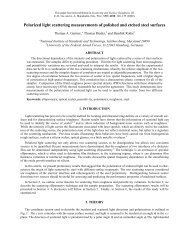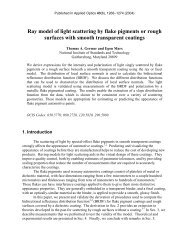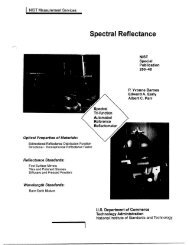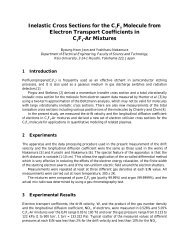A Twin Photon Source Based on Optical Fiber - Physical ...
A Twin Photon Source Based on Optical Fiber - Physical ...
A Twin Photon Source Based on Optical Fiber - Physical ...
You also want an ePaper? Increase the reach of your titles
YUMPU automatically turns print PDFs into web optimized ePapers that Google loves.
Jingyun Fan, Alan Migdall and Lijun Wang<br />
A <str<strong>on</strong>g>Twin</str<strong>on</strong>g> <str<strong>on</strong>g>Phot<strong>on</strong></str<strong>on</strong>g> <str<strong>on</strong>g>Source</str<strong>on</strong>g><br />
A new light<br />
source brings<br />
quantum<br />
cryptography<br />
closer to reality.<br />
26 | OPN March 2007<br />
1047-6938/07/03/0026/6-$15.00 ©OSA<br />
The art of secret communicati<strong>on</strong><br />
is as old as human<br />
history itself. The two major<br />
methods for doing this<br />
are steganography, which<br />
refers to hiding a message<br />
(rarely used in modern<br />
times) and cryptography, or the hiding<br />
of the meaning of a message. Nowadays,<br />
the <strong>on</strong>ly absolutely secure way to encrypt<br />
a message is to shift each letter by a<br />
random amount, and to use that random<br />
“key” <strong>on</strong>ly <strong>on</strong>ce.<br />
Bright<br />
broadband<br />
light generated<br />
in a highly<br />
n<strong>on</strong>linear<br />
microstructure<br />
fiber.<br />
Thus, the most important questi<strong>on</strong> in<br />
cryptography today is how to distribute<br />
a random string of bits between two and<br />
<strong>on</strong>ly two parties—the sender and the<br />
receiver. One soluti<strong>on</strong> to this problem is<br />
public key cryptography (including the<br />
well-known RSA method), which relies<br />
<strong>on</strong> the difficulty of factoring a large number.<br />
However, its absolute security cannot<br />
be guaranteed.<br />
Quantum cryptography takes another<br />
approach. Here, a single phot<strong>on</strong> is the<br />
physical carrier of informati<strong>on</strong>, and its<br />
www.osa-opn.org
<str<strong>on</strong>g>Based</str<strong>on</strong>g> <strong>on</strong> <strong>Optical</strong> <strong>Fiber</strong><br />
quantum mechanical state is used to<br />
encode <strong>on</strong>e bit of the key. While there are<br />
numerous protocols, quantum key distributi<strong>on</strong><br />
fundamentally relies <strong>on</strong> a special<br />
property of the quantum world: A single<br />
phot<strong>on</strong> can be detected <strong>on</strong>ly <strong>on</strong>ce!<br />
In other words, eavesdropping is not<br />
possible: Detecting and duplicating the<br />
single phot<strong>on</strong>’s quantum state—that is,<br />
sending <strong>on</strong>e copy <strong>on</strong>ward in a message and<br />
keeping <strong>on</strong>e as a record—is simply prohibited<br />
by the laws of quantum mechanics.<br />
Even better, the integrity of the key distri-<br />
buti<strong>on</strong> channel (whether an eavesdropper<br />
is listening) can be tested by examining<br />
the errors the channel produces, with<br />
various test quantum states as input.<br />
An excellent way to realize the fantastic<br />
and almost fairy-tale-like applicati<strong>on</strong>s<br />
that might spring from this form of cryptography<br />
is through reliable, high-performance<br />
single- and multi-phot<strong>on</strong> entangled<br />
sources. Practical implementati<strong>on</strong>s<br />
of such sources are most comm<strong>on</strong>ly made<br />
from sources that produce phot<strong>on</strong>s in<br />
pairs. Therefore, researchers are working<br />
hard to build bright robust two-phot<strong>on</strong><br />
light sources that emit phot<strong>on</strong> pairs that<br />
can be built into two- or more-phot<strong>on</strong><br />
entangled states.<br />
In 1970, Burnham and Weinberg<br />
dem<strong>on</strong>strated two-phot<strong>on</strong> light created<br />
by sp<strong>on</strong>taneous parametric down c<strong>on</strong>versi<strong>on</strong><br />
(SPDC) in a n<strong>on</strong>linear crystal. The<br />
30-plus years of optimizati<strong>on</strong> since then<br />
have led to bright two-phot<strong>on</strong> sources.<br />
In SPDC, a pump phot<strong>on</strong> at a high<br />
frequency wp is c<strong>on</strong>verted into two lower<br />
energy phot<strong>on</strong>s (called signal and idler),<br />
OPN March 2007 | 27
satisfying energy c<strong>on</strong>servati<strong>on</strong> wp = w signal<br />
+ w idler , and the phase-matching c<strong>on</strong>diti<strong>on</strong>,<br />
k p = k signal + k idler . In a n<strong>on</strong>linear<br />
crystal, pairs of phot<strong>on</strong>s are often emitted<br />
into a large number of spatial and spectral<br />
modes.<br />
However, for communicati<strong>on</strong>s applicati<strong>on</strong>s,<br />
light must be delivered in just<br />
a single or a few spatial modes and preferably<br />
with a narrow spectral bandwidth.<br />
Th us, researchers inevitably encounter a<br />
large collecti<strong>on</strong> loss when using SPDC as<br />
the source.<br />
An ideal two-phot<strong>on</strong> light source for<br />
quantum informati<strong>on</strong> applicati<strong>on</strong>s would<br />
have high two-phot<strong>on</strong> spectral brightness,<br />
a broad spectral range, output in a singlespatial<br />
mode, negligible background<br />
noise, effi cient collecti<strong>on</strong> and delivery,<br />
and compact physical size.<br />
Th ose familiar with fi ber optics will<br />
immediately think of high-gain fi ber<br />
parametric amplifi ers. Such amplifi ers<br />
have been extensively studied at high<br />
powers for optical signal amplifi cati<strong>on</strong> in<br />
communicati<strong>on</strong> networks. However, the<br />
low power extreme may be ideal for twophot<strong>on</strong><br />
generati<strong>on</strong>. Here, a parametric<br />
four-phot<strong>on</strong> process occurs, where two<br />
pump phot<strong>on</strong>s are c<strong>on</strong>sumed to produce<br />
two output phot<strong>on</strong>s.<br />
<strong>Fiber</strong> n<strong>on</strong>linearity<br />
A typical single-mode optical fi ber (SMF)<br />
is made of fused silica and is cylindrically<br />
symmetric. With proper core size and<br />
refractive index diff erence between the<br />
fi ber core and cladding, light propagates<br />
in a single-spatial mode with low loss.<br />
Th e small eff ective mode area (A eff ) of<br />
the light beam inside the SMF (about<br />
50 mm 2 for l = 1.55 mm), together with<br />
a l<strong>on</strong>g fi ber length (L), leads to a high<br />
overall n<strong>on</strong>linear interacti<strong>on</strong> that is<br />
proporti<strong>on</strong>al to PL/A eff , where P is the<br />
input power.<br />
Because glass is centrosymmetric, sec<strong>on</strong>d-order<br />
n<strong>on</strong>linear susceptibility, χ (2) ,<br />
is absent in SMFs. Hence, the dominant<br />
n<strong>on</strong>linear interacti<strong>on</strong>s in an SMF are χ (3)<br />
processes. Am<strong>on</strong>g third-order n<strong>on</strong>linear<br />
processes, the most important <strong>on</strong>es for<br />
the creati<strong>on</strong> of two-phot<strong>on</strong> light are<br />
28 | OPN March 2007<br />
Raman gain [x10 –13 m/W]<br />
Energy diagrams for<br />
[ SFWM and Raman scattering ]<br />
|g><br />
|a> ><br />
wP1 P1 |n><br />
|n><br />
|g><br />
w<br />
w idler<br />
w idler<br />
SFWM<br />
RS<br />
|e><br />
|b><br />
wP2 P2 |n><br />
|n><br />
|g><br />
w signal<br />
In sp<strong>on</strong>taneous four-wave mixing<br />
(SFWM), two phot<strong>on</strong>s are absorbed<br />
from the pump fi elds (w P1 and w P2 ) to<br />
create two new phot<strong>on</strong>s w signal and w idler<br />
that are correlated due to energy c<strong>on</strong>servati<strong>on</strong>.<br />
In Raman scattering a single<br />
pump phot<strong>on</strong> interacts with a ph<strong>on</strong><strong>on</strong><br />
to produce a phot<strong>on</strong> of higher/lower<br />
energy w signal /w idler .<br />
1.2<br />
1.0<br />
0.8<br />
0.6<br />
0.4<br />
0.2<br />
w<br />
w signal<br />
[ ]<br />
Raman scattering gain<br />
in a typical fused silica SMF<br />
l P = 1 mm<br />
P<br />
0<br />
0 6 12 18 24 30 36 42<br />
Frequency shift [THz]<br />
sp<strong>on</strong>taneous four-wave mixing (SFWM)<br />
and sp<strong>on</strong>taneous Raman scattering (RS).<br />
SFWM and RS typically occur<br />
together. At low power, SFWM is often<br />
called four-phot<strong>on</strong> scattering, where two<br />
phot<strong>on</strong>s from the pump fi eld or fi elds are<br />
absorbed to create a two-phot<strong>on</strong> state. RS,<br />
<strong>on</strong> the other hand, shifts a single-pump<br />
phot<strong>on</strong> to a diff erent wavelength, result-<br />
ing in the main noise background for the<br />
two-phot<strong>on</strong> light created by SFWM.<br />
In the fi gure <strong>on</strong> the left, we readily<br />
see the physical origin of twin phot<strong>on</strong><br />
generati<strong>on</strong>. Here, two pump phot<strong>on</strong>s<br />
(wp 1 and wp 2 ) are c<strong>on</strong>sumed to create<br />
w signal and w idler . Th ese two new phot<strong>on</strong>s<br />
are created simultaneously to satisfy<br />
energy c<strong>on</strong>servati<strong>on</strong>. Because the two<br />
modes, signal and idler, initially have no<br />
phot<strong>on</strong>s in them, the newly created twin<br />
phot<strong>on</strong>s can be perfectly correlated.<br />
For cryptography, the signal phot<strong>on</strong><br />
can be sent out as the carrier, while the<br />
idler is detected as a trigger to indicate<br />
that a signal phot<strong>on</strong> has been generated<br />
and sent out. Th e Raman process is the<br />
main source of error that can destroy<br />
this perfect correlati<strong>on</strong>. For example, if<br />
the Raman process <strong>on</strong>ly adds a signal<br />
phot<strong>on</strong> without an idler, it will spoil the<br />
correlati<strong>on</strong>.<br />
Th e effi ciency and spectrum of SFWM<br />
is mainly governed by phase-matching<br />
through fi ber dispersi<strong>on</strong> and Kerr-n<strong>on</strong>linearity<br />
(n 2 ). Th e fi ber dispersi<strong>on</strong> is<br />
determined by both material dispersi<strong>on</strong><br />
and waveguide dispersi<strong>on</strong> and leads to the<br />
propagati<strong>on</strong> phase-mismatch Dkz = (kp 1 +<br />
kp 2 –k signal –k idler )z of the four diff erent<br />
optical fi elds in the SMF, where z is the<br />
propagati<strong>on</strong> distance. Th e Kerr-n<strong>on</strong>linearity<br />
is the optical power-induced variati<strong>on</strong><br />
of refractive index that causes a shift<br />
of the phase-mismatch by g(P 1 + P 2 )z.<br />
Here, g is the n<strong>on</strong>linear gain coeffi<br />
cient with g = 2πn 2 /lA eff . When these<br />
two phases cancel in an SMF, the SFWM<br />
is phase-matched, with Dkz + g(P 1 + P 2 )z<br />
= 0. Energy is transferred from the pump<br />
fi elds (wp 1 and wp 2 ) to the initially absent<br />
signal (w signal ) and idler (w idler ) fi elds as<br />
the four fi elds propagate together in the<br />
fi ber.<br />
Th e Raman process in fused silica<br />
SMFs has been l<strong>on</strong>g known. Fundamentally,<br />
pump phot<strong>on</strong>s induce transiti<strong>on</strong>s in<br />
the fi ber glass vibrati<strong>on</strong>al bands. Th is is<br />
frequently described as an inelastic scattering<br />
process and characterized as a ph<strong>on</strong><strong>on</strong><br />
exchange process. Th e amorphous<br />
nature of fused silica spreads the otherwise<br />
limited Raman transiti<strong>on</strong> bandwidth<br />
into a c<strong>on</strong>tinuum.<br />
www.osa-opn.org
Am<strong>on</strong>g third-order n<strong>on</strong>linear processes, the most important <strong>on</strong>es for the<br />
creati<strong>on</strong> of two-phot<strong>on</strong> light are sp<strong>on</strong>taneous four-wave mixing (SFWM) and<br />
sp<strong>on</strong>taneous Raman scattering (RS).<br />
The RS spectrum in a fused silica SMF<br />
extends for about 40 THz (Dw, detuning<br />
from the pump frequency) and peaks at<br />
Dw
Degenerate SFWM with a large<br />
frequency detuning in an MF<br />
The most frequently used SFWM<br />
scheme takes two phot<strong>on</strong>s absorbed from<br />
the same pump field (wp) to create a pair<br />
of signal and idler phot<strong>on</strong>s, w signal – wp =<br />
<str<strong>on</strong>g>Phot<strong>on</strong></str<strong>on</strong>g> pair prod. rate [MHz]<br />
4<br />
2<br />
30 | OPN March 2007<br />
[ Two-phot<strong>on</strong> and single-phot<strong>on</strong> light ]<br />
(a) (d)<br />
(b)<br />
Coincidence rate [kHz]<br />
40<br />
20<br />
0<br />
Idler<br />
Idler Raman<br />
Signal<br />
Coincidence<br />
Accidental<br />
Signal Raman<br />
FWM pair<br />
10 2<br />
10 1<br />
10 0<br />
10 0<br />
10 –1<br />
10 –2<br />
Single phot<strong>on</strong> rate [kHz]<br />
Raman phot<strong>on</strong> prod. rate [MHz]<br />
0<br />
(c)<br />
1.0<br />
(f)<br />
2-phot<strong>on</strong><br />
————————————————<br />
2-phot<strong>on</strong> + Raman phot<strong>on</strong><br />
0.5<br />
2-phot<strong>on</strong><br />
———————————————<br />
2-phot<strong>on</strong> + signal Raman<br />
2-phot<strong>on</strong><br />
———————————————<br />
2-phot<strong>on</strong> + idler Raman<br />
0.0<br />
0.0 0.5<br />
Pump power [mW]<br />
1.0<br />
wp – widler . When the pump wavelength<br />
is close to lZDW , a large frequency detuning<br />
Dw is needed for efficient SFWM.<br />
Appropriate dispersi<strong>on</strong> management can<br />
move the SFWM gain away from the Raman<br />
peak so that the single-phot<strong>on</strong> noise<br />
background is low.<br />
We examined the two-phot<strong>on</strong> and single-phot<strong>on</strong> light produced in a 1.7 m MF (g=100/W/km)<br />
with an 8 ps laser pulse at a repetiti<strong>on</strong> rate of 80 MHz. From the measured signal phot<strong>on</strong><br />
(D signal), idler phot<strong>on</strong> (D idler), two-phot<strong>on</strong> coincidence (D coin) and accidental (D acc) rates, plotted<br />
in (a), we estimated the single phot<strong>on</strong> (N signal and N idler) and two-phot<strong>on</strong> producti<strong>on</strong> (N two)<br />
rates using detecti<strong>on</strong> efficiencies h signal and h idler. N two = (D coin– D acc)/(h signalh idler), N signal =<br />
D signal/h signal – N two, N idler = D idler/ h idler – N two. They are plotted in (b). We further estimated the<br />
ratios N two/(N two + N signal) and N two/(N two + N idler) representing the c<strong>on</strong>trast of SFWM to Raman<br />
at the collected signal and idler wavelengths; they are plotted in (c). With this phot<strong>on</strong> counting<br />
method, we obtained the Raman spectrum by scanning the idler and signal wavelengths<br />
using a fused silica polarizati<strong>on</strong>-maintaining MF (g = 70/W/km, l ZDW = 745 +/– 5 nm, length =<br />
1.7 m), as shown in (d). We measured two-phot<strong>on</strong> light with high spectral brightness over a<br />
broad bandwidth and high C/A, as shown in (e) and (f).<br />
(e)<br />
Normalized Raman gain<br />
Coincidence rate [Hz]<br />
C/A<br />
1.0<br />
0.5<br />
0.0<br />
10 5<br />
10 4<br />
10 3<br />
10 2<br />
10 1<br />
1,000<br />
100<br />
10<br />
150 mW<br />
100 mW<br />
75 mW<br />
50 mW<br />
30 mW<br />
20 mW<br />
0 10 20 30 40<br />
Frequency detuning [THz]<br />
In our experiment, we optimize the<br />
overall SFWM gain and the SFWM gain<br />
with respect to the Raman gain, using a<br />
two-pass grating that enhances the signal<br />
collecti<strong>on</strong> and suppresses noise. The<br />
set-up is somewhat similar to an optical<br />
stretcher (or compressor) comm<strong>on</strong>ly<br />
used in ultra-fast lasers to implement<br />
chirped-pulse amplificati<strong>on</strong>. This twopass<br />
c<strong>on</strong>figurati<strong>on</strong> accomplishes three<br />
functi<strong>on</strong>s: (1) selecti<strong>on</strong> of frequency-correlated<br />
signal and idler phot<strong>on</strong>s created<br />
by the SFWM process; (2) double-rejecti<strong>on</strong><br />
of phot<strong>on</strong>s at other wavelengths; and<br />
(3) preparati<strong>on</strong> of the selected phot<strong>on</strong>s<br />
back into a single-spatial mode for high<br />
collecti<strong>on</strong> efficiency.<br />
At a big detuning of the signal and<br />
idler from the pump, we measured a<br />
high two-phot<strong>on</strong> coincidence rate of<br />
1 kHz per bandwidth of 0.44 THz over<br />
a 10 THz spectra range (from Dw =<br />
20 THz to 30 THz), with C/A > 100<br />
with the pump wavelength close to l ZDW<br />
at an average pump power of 30 mW<br />
coupled into a polarizati<strong>on</strong>-maintaining<br />
MF (g = 70 /W/km, L = 1.7 m). The<br />
10 THz bandwidth provides an opportunity<br />
to use two-phot<strong>on</strong> light al<strong>on</strong>g<br />
with WDM comp<strong>on</strong>ents comm<strong>on</strong> in<br />
telecom networks. The estimated twophot<strong>on</strong><br />
producti<strong>on</strong> rate per bandwidth<br />
per mW pump power is comparable to<br />
the best SPDC-based sources (about<br />
100 kHz/mW/THz).<br />
The spectral brightness over a broad<br />
bandwidth in single spatial mode with<br />
very low background noise, combined<br />
with the sophisticated fiber optical<br />
technology and compatibility to global<br />
network, provides an all-fiber-based<br />
two-phot<strong>on</strong> source with great potential.<br />
Operated at room temperature, SFWM<br />
with large Dw also offers better spectral<br />
brightness, available bandwidth, background<br />
noise, flexibility, and stability<br />
than SFWM with small Dw.<br />
Moving the pump wavelength further<br />
toward the normal dispersi<strong>on</strong> regi<strong>on</strong><br />
requires a large Dw for efficient SFWM.<br />
One is able to design an MF with appropriate<br />
dispersi<strong>on</strong> to allow pumping<br />
at 1,064 nm to create the idler phot<strong>on</strong><br />
at 1,310 nm and the signal phot<strong>on</strong> at<br />
www.osa-opn.org
In our experiment, we optimize the overall SFWM gain and the SFWM gain<br />
with respect to the Raman gain, using a two-pass grating that enhances the<br />
signal collecti<strong>on</strong> and suppresses noise.<br />
895 nm. This adds c<strong>on</strong>venience, as the<br />
signal phot<strong>on</strong> can be detected with silic<strong>on</strong><br />
avalanche photodiode with its high<br />
detecti<strong>on</strong> efficiency at 895 nm. Rarity<br />
and his colleagues recently dem<strong>on</strong>strated<br />
an experiment of this sort (Opt. Express<br />
13, 534 and 7572).<br />
Two-phot<strong>on</strong> quantum entanglement<br />
can be built from SFWM-produced<br />
two-phot<strong>on</strong> light in a number of ways. In<br />
the co-propagating scheme, two crosspolarized<br />
pump beams are coupled into<br />
the fiber, each creating a correlated twophot<strong>on</strong><br />
state al<strong>on</strong>g its polarizati<strong>on</strong> in the<br />
form of H s H i or V s V i (H and V indicate<br />
horiz<strong>on</strong>tal and vertical polarizati<strong>on</strong>s and<br />
s and i indicate signal and idler phot<strong>on</strong>s,<br />
respectively.)<br />
With appropriate c<strong>on</strong>trol of temporal<br />
coherence and polarizati<strong>on</strong>, these two<br />
phot<strong>on</strong> pairs are indistinguishable up<strong>on</strong><br />
exiting the fiber and so can form Bell<br />
states. The Northwestern team dem<strong>on</strong>strated<br />
such an experiment.<br />
Counter-propagating and two-fiber<br />
schemes are also used to prepare polarizati<strong>on</strong>-entangled<br />
two-phot<strong>on</strong> light.<br />
With two identical pump beams counter-propagating<br />
in an optical fiber, each<br />
creates a two-phot<strong>on</strong> state via SFWM.<br />
By combining the two-phot<strong>on</strong> pairs<br />
together, four Bell states can be prepared<br />
with appropriate polarizati<strong>on</strong> and phase<br />
c<strong>on</strong>trols. Polarizati<strong>on</strong> entanglement can<br />
also be obtained.<br />
This was recently dem<strong>on</strong>strated by the<br />
Northwestern and NTT teams (Phys.<br />
Rev. Lett. 94, 053601, Opt. Lett. 31,<br />
1905 and 1286, and Phys. Rev. A 72,<br />
041804R). Rarity and his colleagues<br />
showed H<strong>on</strong>g-Ou-Mandel (HOM)<br />
interference using the two-phot<strong>on</strong> light<br />
created in SFWMs in two separate but<br />
identical optical fibers. Using the coincidence<br />
of the two signal phot<strong>on</strong>s as the<br />
gate, they observed HOM interference<br />
between the two idler phot<strong>on</strong>s after a<br />
beamsplitter.<br />
[ Creati<strong>on</strong> of two-phot<strong>on</strong> light and Bell states through degenerate SFWM ]<br />
Counter-propagating<br />
E y<br />
l/4<br />
E x<br />
PBS<br />
Grating<br />
H s & V s<br />
Mirror<br />
Slit<br />
½ l<br />
Bell states H s H i ± V s V i<br />
H s V i ± V s H i<br />
x<br />
<strong>Fiber</strong><br />
y<br />
H s H i<br />
H i & V i<br />
z<br />
A two-pass grating c<strong>on</strong>figurati<strong>on</strong> is used. The signal and idler phot<strong>on</strong>s selected by<br />
adjustable slits are focused back <strong>on</strong>to the grating, and put back into single spatial modes<br />
up<strong>on</strong> exiting the grating. They are collected into SMFs and fed into single-phot<strong>on</strong> detectors.<br />
A pair of cross-polarized pump beams co-propagate in the fiber, with each beam<br />
creating a two-phot<strong>on</strong> state H s H i (or V s V i ). The two phot<strong>on</strong>s are indistinguishable up<strong>on</strong><br />
exiting the fiber, forming two-phot<strong>on</strong> entanglement H s H i + V s V i . Other Bell states can be<br />
made with appropriate delay and polarizati<strong>on</strong> c<strong>on</strong>trol.<br />
V s V i<br />
Mirror<br />
Slit<br />
Coupler<br />
Two-fiber HOM<br />
Coincidence<br />
<strong>Fiber</strong><br />
Grating<br />
<strong>Fiber</strong><br />
Schemes for creati<strong>on</strong> of Bell states and the H<strong>on</strong>g-Ou-Mandel interference experiment.<br />
PBS: polarizing beam splitter; BS: 50/50 n<strong>on</strong>-polarizing beam splitter.<br />
l/2<br />
Bell states H s H i ± V s V i<br />
H s V i ± V s H i<br />
BS<br />
Grating<br />
[ Counter-propagating and two-fiber pump schemes ]<br />
BS<br />
OPN March 2007 | 31
Reverse degenerate SFWM with different polarizati<strong>on</strong> inputs can create the output two phot<strong>on</strong>s in different polarizati<strong>on</strong> states for postselective<br />
Bell measurements or H<strong>on</strong>g-Ou-Mandel interference. (a) Determinati<strong>on</strong> of two-phot<strong>on</strong> correlati<strong>on</strong> in a reverse degenerate<br />
SFWM process. (b) Measurement of two-phot<strong>on</strong> brightness as a functi<strong>on</strong> of pump power. Experiment was performed with two 1.7 m<br />
MFs (g = 100/W/km), pumped by an 8 ps laser pulse at l ZDW =735 nm.<br />
32 | OPN March 2007<br />
Mirrors<br />
MF 1<br />
MF 2<br />
<strong>Fiber</strong> coupler<br />
HH, VV or HV<br />
Bell state HOM<br />
HV<br />
BS<br />
(a) (b)<br />
lidler lsignal Intensity [mW/nm]<br />
10<br />
1<br />
0.1<br />
l s–2<br />
l s–3<br />
l s–1<br />
<strong>Fiber</strong><br />
Grating<br />
l i+1<br />
l s–2<br />
l i+2<br />
820 830 840 850<br />
Wavelength [nm]<br />
l i+2<br />
[ Reverse degenerate SFWM with different polarizati<strong>on</strong> ]<br />
HV<br />
l/2<br />
PBS<br />
Gratings<br />
BS<br />
[ Setup for cascaded n<strong>on</strong>-degenerate FWMs ]<br />
l i+3<br />
l i+1<br />
l idler<br />
l signal<br />
l s–1<br />
l s–1 and l i+1<br />
Setup with w signal + w idler = w s–1 + w i+1 = w s–2 + w i+2 = w s–2 + w i+3 . The induced photocurrents<br />
by signal and idler beams <strong>on</strong> the photo-diodes are fed into a phase-mixer to<br />
produce and that are c<strong>on</strong>nected to a spectrum analyzer. (a) Measured<br />
spectrum for cascaded FWMs. (b) Measured noise cross-correlati<strong>on</strong> between signal<br />
and idler beams.<br />
+/–<br />
l s–2 and l i+2<br />
l signal and l idler<br />
0.5 1.0<br />
Psignal + Pidler [mW]<br />
Phase-mixer<br />
RF<br />
analyzer<br />
(a)<br />
(b)<br />
1.0<br />
0.9<br />
0.4<br />
0.2<br />
0.0<br />
C/A<br />
Coincidence rate [Hz]<br />
(–)/(+)<br />
1.4<br />
1.2<br />
Idler<br />
Signal<br />
C/A<br />
1.0<br />
–1.0 –0.5 0.0 0.5<br />
0.0<br />
1.0<br />
Wavelength mismatch [nm]<br />
600<br />
400<br />
200<br />
C/A<br />
Coincidence<br />
Accidental<br />
0<br />
0.0 0.3 0.6<br />
P [W]<br />
0.9 1.2<br />
0<br />
1.0x10 5<br />
5.0x10 4<br />
C/A<br />
Reversed degenerate SFWM<br />
Single counts [Hz]<br />
The reverse degenerate FWM process<br />
wp 1 + wp 2 —> w signal + w idler can also<br />
occur. Normally, when there are two or<br />
more pump wavelengths, many FWM<br />
processes can appear, but stimulated<br />
degenerate FWM dominates. In most<br />
experiments reported so far with two<br />
pump wavelengths wp 1 < wp 2 , the two<br />
stimulated degenerate FWM processes<br />
2wp 1 —> w signal + wp 2 and 2wp 2 —> wp 1 +<br />
w idler have dominated over the sp<strong>on</strong>taneous<br />
n<strong>on</strong>-degenerate FWM process: wp 1 +<br />
wp 2 —> w signal + w idler . Recently, we saw<br />
the dominance of this reverse degenerate<br />
FWM process, with the twin phot<strong>on</strong>s<br />
generated at the mean frequency being<br />
highly correlated (Opt. Lett. 30, 1530<br />
and 3368).<br />
When the dispersi<strong>on</strong> slowly varies near<br />
l ZDW , phase-matching or quasi-phasematching<br />
can be easily satisfied between<br />
the pump, signal and idler fields at low<br />
power. By arranging a pair of pump<br />
beams with frequencies (w signal + w idler )<br />
c<strong>on</strong>jugate with respect to l ZDW , such a<br />
8<br />
4<br />
www.osa-opn.org
An all-fiber-based two-phot<strong>on</strong> light source has advantages in high spectral<br />
brightness, broad bandwidth, single spatial mode, low noise background, low<br />
collecti<strong>on</strong> loss, compact physical size, low pump power and compatibility with<br />
an optical network.<br />
process w signal + w idler —> 2w ZDW can<br />
occur and dominate. This is a reversed<br />
degenerate SFWM process.<br />
In our experiment, we put two identical<br />
MFs in series and coupled a laser<br />
pulse into the first MF to create a broadband<br />
light pulse. The output is sent to a<br />
two-pass grating to select a pair of c<strong>on</strong>jugate<br />
signal and idler pump wavelengths.<br />
This pair of pump beams is then coupled<br />
into the sec<strong>on</strong>d MF. Using another twopass<br />
grating arrangement, we collected<br />
<strong>on</strong>ly phot<strong>on</strong>s at l ZDW . Measurements<br />
show that this light appears mostly in<br />
pairs, indicating that n<strong>on</strong>-degenerate<br />
SFWM dominates. The brightness of<br />
this two-phot<strong>on</strong> light is comparable to<br />
that of SPDC.<br />
Researchers and engineers have been<br />
c<strong>on</strong>sistently interested in studying the<br />
correlati<strong>on</strong> between the Stokes and anti-<br />
Stokes light created by degenerate FWM<br />
with a single pump wavelength. However,<br />
no correlati<strong>on</strong> studies have been made of<br />
FWM with multiple pump wavelengths;<br />
this is due to the assumpti<strong>on</strong> that there<br />
is no direct correlati<strong>on</strong> between the<br />
Stokes and anti-Stokes beams because<br />
of the dominance of degenerate FWM<br />
amplificati<strong>on</strong>.<br />
C<strong>on</strong>tinuing with the reverse degenerate<br />
FWM experiment, we examined the<br />
noise cross-correlati<strong>on</strong> between those<br />
created twin spectral side bands that are<br />
restricted by w signal + w idler = w s–1 + w i+1 =<br />
w s–2 + w i+2 . The photo-currents induced<br />
by the signal and idler light in photodiodes<br />
are c<strong>on</strong>nected to a phase-mixer to<br />
produce sum- and difference-currents<br />
I+ and I–, which are c<strong>on</strong>nected to a spectrum<br />
analyzer for noise analysis. When<br />
the twin beams are perfectly correlated,<br />
= 0. When they are completely<br />
uncorrelated, = .<br />
Corresp<strong>on</strong>dingly, a classical noise correlati<strong>on</strong>,<br />
defined as ( – )/(<br />
– ), equals to 1 for perfect correla-<br />
ti<strong>on</strong> and 0 for no correlati<strong>on</strong> between the<br />
two beams, assuming equal detecti<strong>on</strong> efficiencies.<br />
When reverse degenerate FWM<br />
dominates at the middle frequency, we<br />
measured increased noise cross-correlati<strong>on</strong><br />
between the signal and idler beams<br />
of higher order processes. By varying the<br />
wavelength of <strong>on</strong>e of the two inputs to<br />
the sec<strong>on</strong>d fiber, we found that the measured<br />
difference-current quickly reaches<br />
to the level of the sum-current, resulting<br />
in a reduced classical noise correlati<strong>on</strong>.<br />
This shows that the n<strong>on</strong>-degenerate<br />
FWM dominates in the cascaded FWM<br />
processes as well.<br />
A bright future for single<br />
phot<strong>on</strong> sources<br />
Quantum behavior of light is most<br />
profound when the light is c<strong>on</strong>trolled to<br />
come <strong>on</strong>e phot<strong>on</strong> at a time. This is true<br />
for textbook experiments, theoretical or<br />
real, as well as for real-world applicati<strong>on</strong>s<br />
of quantum cryptography. In the past<br />
35 years or so, researchers have developed<br />
various ways of generating <strong>on</strong>e phot<strong>on</strong><br />
of light at a time. The most comm<strong>on</strong><br />
methods used are variants of sp<strong>on</strong>taneous<br />
parametric down-c<strong>on</strong>versi<strong>on</strong> (SPDC), in<br />
which a UV laser beam is typically used<br />
to generate two infrared phot<strong>on</strong>s at <strong>on</strong>ce.<br />
Compared to an SPDC two-phot<strong>on</strong><br />
light source, an all-fiber-based twophot<strong>on</strong><br />
light source has advantages<br />
in high spectral brightness, broad<br />
bandwidth, single spatial mode, low noise<br />
background, low collecti<strong>on</strong> loss, compact<br />
physical size, low pump power and<br />
compatibility with an optical network.<br />
With appropriate dispersi<strong>on</strong> c<strong>on</strong>trol,<br />
fiber-based two-phot<strong>on</strong> light sources<br />
can cover the spectral range from UV to<br />
the infrared, all in a single spatial mode,<br />
meeting wavelength requirements for<br />
quantum communicati<strong>on</strong> and possibly<br />
other applicati<strong>on</strong>s.<br />
Understandably, this new technique<br />
is still in its infancy. Only a few years<br />
have passed since it was first proposed.<br />
However, it’s already showing promise.<br />
With more R&D effort, particularly from<br />
the engineering aspect, it is c<strong>on</strong>ceivable<br />
that <strong>on</strong>e day a cheap, robust, plugand-play<br />
single-phot<strong>on</strong> source will be<br />
ubiquitous in real-world cryptography<br />
systems. t<br />
The authors gratefully acknowledge the support<br />
from the Japan Science and Technology<br />
Foundati<strong>on</strong> (JST), the MURI Center for<br />
<str<strong>on</strong>g>Phot<strong>on</strong></str<strong>on</strong>g>ic Quantum Informati<strong>on</strong> Systems<br />
and the DTO entangled phot<strong>on</strong> source<br />
program.<br />
[ Jingyun Fan (Jfan@nist.gov) and Alan<br />
Migdall (Migdall@nist.gov) are with the <strong>Optical</strong><br />
Technology Divisi<strong>on</strong> of the Nati<strong>on</strong>al Institute<br />
of Standards and Technology (NIST) and the<br />
Joint Quantum Institute of the University of<br />
Maryland. Lijun Wang (lwan@ioip.mpg.de) is<br />
with the Max-Planck Research Group, Institute<br />
of Optics, Informati<strong>on</strong> and <str<strong>on</strong>g>Phot<strong>on</strong></str<strong>on</strong>g>ics,<br />
Member<br />
University of Erlangen, Germany. ]<br />
[ References and Resources ]<br />
>> D.C. Burnham and D.L. Weinberg. Phys.<br />
Rev. Lett. 25, 84 (1970).<br />
>> L.J. Wang et al. NEC Research Inst. Technical<br />
Report, TR99-106 (1999).<br />
>> L.J. Wang et al. J. Opt. B: Quantum Semiclass.<br />
Opt. 3, 346 (2001).<br />
>> J.E. Sharping et al. Opt. Lett. 26, 367<br />
(2001).<br />
>> H. Takesue and K. Inoue. Phys. Rev. A 70,<br />
031802R (2004).<br />
>> J. Fan et al. Opt. Lett. 30, 1530 (2005).<br />
>> J. Fan et al. Opt. Lett., 30, 3368 (2005).<br />
>> J. Fulc<strong>on</strong>is et al. Opt. Express 13, 7572<br />
(2005).<br />
>> X. Li et al. Phys. Rev. Lett. 94, 053601<br />
(2005).<br />
>> J.G. Rarity et al. Opt. Express 13, 534<br />
(2005).<br />
>> H. Takesue and K. Inoue. Phys. Rev. A 72,<br />
041804R (2005).<br />
>> K.F. Lee et al. Opt. Lett. 31, 1905 (2006).<br />
>> Q. Lin et al. Opt. Lett. 31, 1286 (2006).<br />
OPN March 2007 | 33


